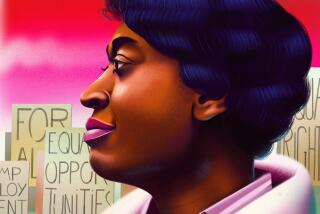The Road Not Taken : BAYARD RUSTIN: Troubles I’ve Seen.<i> By Jervis Anderson</i> .<i> HarperCollins: 418 pp., $30</i>
Bayard who? It is probably safe to say that Bayard Rustin’s name is not very well recognized these days. In the 1950s and 1960s, Rustin was an important and controversial figure, and no doubt his legacy will continue to be disputed by those who manned the barricades of the early civil rights movement.
But to a new generation born in the aftermath of the great victories of the 1950s and 1960s--the Brown decision, the Civil Rights Act, the Voting Rights Act and fair housing legislation--Rustin is a virtual unknown. In the memory of younger people, Martin Luther King is the canonized saint of the civil rights movement, one or two others, like Andrew Young and Joseph Lowery, are still around and vaguely familiar, and Rustin has completely disappeared.
Thus it is Jervis Anderson’s challenge in “Bayard Rustin: Troubles I’ve Seen” to introduce Rustin to younger readers by explaining why he was important and why his ideas matter today. In addition, Anderson could stimulate the interest of older readers, already familiar with Rustin, by offering a provocative interpretation of his legacy. Rustin died in 1987, and no one seems to have mentioned him since: Is it too much to ask of a biographer that he bring his subject back to life?
Alas, in this case it is. Anderson, who once worked for Rustin at the A. Philip Randolph Institute and has been a staff writer for the New Yorker since 1968, has mined Rustin’s writings and interviewed Rustin’s friends and associates to give us a competent and readable account of his subject’s life. Anderson’s strength is his consistent reliability as a reporter, as well as his attention to detail.
Yet, ultimately, this book misses the forest for the trees. Anderson is content to recite the events of Rustin’s life and quote amply from his writings without making an adequate case for their broader historical or contemporary significance. This biography is unable to locate Rustin’s vision in the context of an ongoing struggle for the soul of black America.
For readers who do not already know Rustin well, Anderson’s book reads like a belated and rather detailed obituary of a second-stringer, who happened to advise King and get into scraps with other guys like Stokely Carmichael before being consigned to the sidelines of the civil rights leadership for two decades (although lots of big names turned up at his funeral). The author fails to convincingly answer the question: Why should anybody today care about Bayard Rustin?
Anderson’s attempt at an answer is as follows. Born in West Chester, Penn., in 1912, Rustin became a pacifist in his youth and was imprisoned as a conscientious objector during World War II. He was a founder of the Congress of Racial Equality in the 1940s. He met King in the early 1950s and helped to organize the Montgomery, Ala., bus boycott in 1955. He drafted the blueprint for the Southern Christian Leadership Conference that became King’s vehicle for nonviolent activism. He was also the chief architect of the Aug. 28, 1963, march on Washington, where King delivered his famous “I Have a Dream” speech. He went on to head the A. Philip Randolph Institute in the 1960s and 1970s, when his clashes with mainstream civil rights leaders caused him to become marginalized.
Despite this setback, Anderson assures his readers that Rustin remained an engaging fellow to the last. He enjoyed an active homosexual life and yet “had a charmed eye for beautiful women, black and white.” He was “one of the finer amateur judges of Renaissance painting” and maintained an excellent collection of African sculpture and the indigenous art of folk societies. He was “an excellent singer not only of Negro spirituals but also of arias by Bach.”
Anderson has penned a tribute to a modern Renaissance man whom he considers the “shrewdest theoretician” and “most talented organizer” of the civil rights movement. Yet he sells his subject short by failing to capture the most enduring aspect of Rustin, which is his unique place in the evolving ideological history of the black freedom struggle. Rustin’s marginalization in later life, downplayed by Anderson as if it constituted a regrettable chapter in an otherwise luminous life, is actually the most important part of his legacy, because his views represent the road not taken. The main reason for us to think about Rustin today is that his vision might offer new alternatives in a race debate that seems utterly polarized and paralyzed. Rustin alienated himself from the civil rights establishment in the late 1960s and 1970s because he saw political agitation as a necessary step, but only the first step, in securing the American dream for blacks. Once blacks were granted the same legal status as whites, Rustin believed, the civil rights movement should shift gears “from protest to politics,” as he put it in a famous 1965 essay of that name.
Rustin argued that blacks should participate in coalition politics, making common cause with unions and other progressive forces to secure the resources required to raise the economic and cultural level of the community. Rustin was especially keen that blacks preserve their alliance with Jewish groups, not just out of gratitude for assistance given during the early civil rights era but also because Rustin admired the way that Jews had navigated around the shoals of anti-Semitism to become one of the most successful and influential groups in American life.
Moreover, throughout his life, Rustin viewed civil rights as part of a broader campaign for human rights, based on what he termed “the oneness of the human family.” He remained an integrationist and a patriot who never lost faith in the colorblind ideal. He believed that blacks could preserve their cultural identity and yet fully participate in the political and economic life of the nation. He thought of America as a wonderful club that he did not want to see destroyed; he simply wanted the membership rules to be liberalized so that previously excluded groups could enjoy the beautiful landscape of freedom and opportunity without being impeded by their race or background.
For a variety of reasons, the mainstream civil rights leaders rejected this vision, opting instead for a separatist and oppositional stance that continues to define black identity and aspirations against those of the larger society. This approach has brought some short-term gains, to be sure, but it also seems to have isolated millions of African Americans, especially the urban underclass, from a full sense of participation, as well as from full access to the economic rewards of American life.
Anderson’s biography takes perfunctory note of these changes but offers no analysis of what they mean or why they are closely implicated in our current predicament. Still, it is possible for attentive readers to benefit from this mediocre book if only to discover the importance of Bayard Rustin. In rejecting Rustin’s cooperative and integrationist agenda, the civil rights establishment started down a controversial path that has brought it to the current impasse. If the movement is ever going to recapture the moral high ground, its leaders and well-wishers might begin by reassessing their rejection of Rustin’s vision.
More to Read
Sign up for our Book Club newsletter
Get the latest news, events and more from the Los Angeles Times Book Club, and help us get L.A. reading and talking.
You may occasionally receive promotional content from the Los Angeles Times.






